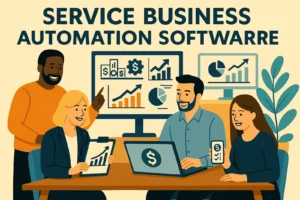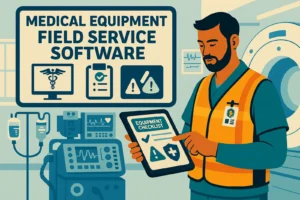Contracts don’t fail because people are lazy. They fail because details drift—old rates linger, SLAs are vague, credits get approved by email, and nobody can reconcile what was promised with what actually happened. Service Contract Management Software fixes that drift. It turns agreements into living rules that guide work, pricing, communications, and renewals. Customers see steady service; finance sees clean numbers; your team sees fewer debates and more predictable days.
Here’s the best part: you don’t need a six-month rollout. Start small, prove lift, and expand. With Shifton, you can pilot the core toolkit for a full month at no cost—set up SLAs, link work orders and rates, and send audit-ready reports without changing your entire stack on day one.
Service Contract Management Software issues across sites & shifts
Stop thinking of contracts as PDFs. Service Contract Management Software turns them into rules your tools can enforce:
Scope & rate libraries. Every task code knows its price, unit, and inclusions. Overages and exceptions are explicit.
SLA timers. Response/restore windows start automatically; breach risk shows up before you miss.
Entitlements & credits. Prepaid hours, site caps, warranty terms, and earned credits apply themselves.
Change control. Adds and deletes get logged with who/when/why—no side deals.
Customer communications. Confirmation, on-the-way, and closure emails respect the contract template.
Proof of service. Photos, signatures, and time/parts tie the bill to the promise, not to memory.
Run this through every job and you get fewer surprises and faster renewals. That is the daily value of Service Contract Management Software.
Where teams stumble (even with great people)
Rates drift. Someone copies last year’s invoice line. Two months later, finance discovers a gap.
Vague SLAs. Dispatch “tries their best” without a clock. Customers feel ignored.
Hidden credits. A manager promises a goodwill hour in email; accounting never sees it.
Scope creep. Techs try to help and turn a 30-minute visit into a free project.
Renewals by hope. Sales asks, “Are they happy?” instead of “Did we meet the contract?”
Service Contract Management Software pulls these into one loop—so promises match delivery, and delivery matches billing.
What good looks like in the field
The ticket is tagged to a contract. The system knows the site, entitlements, rates, and SLA.
Dispatch sees breach risk at 10:30 a.m., not at 6:58 p.m.
Tech opens a checklist that fits the contracted scope; off-scope steps require approval.
Parts pulled and time punched map to charge types automatically.
The closure report reads like the contract: what was covered, what was billable, photos, and signatures.
Finance exports a clean invoice—no manual math.
That’s Service Contract Management Software doing its job: fewer fire drills, cleaner handoffs, steadier margins.
What is Service Contract Management Software (the plain answer)
Service Contract Management Software is the operating system for agreements. It stores the promise (scope, rates, SLAs) and uses it to steer planning, work orders, communications, and billing—so customers get what they bought and you get paid for what you delivered.
A practical rollout you can finish this month
Pick five contracts (one simple, two medium, two messy).
Model the rules: task codes, rates, SLAs, entitlements, and credit logic.
Connect to work orders so jobs inherit rules automatically.
Publish two templates: confirmation and closure emails with contractual wording.
Run for two weeks; compare billed vs. promised, SLA hits, and disputes.
Fix the friction (usually scope tags or credit logic), then add the next batch.
Want help setting this up? Create your workspace in minutes: Registration. Prefer a tour with your contracts? Book time here: Book a Demo. Need the full field stack around routing, time, and parts? Start here: Field Service Management.
How Service Contract Management Software protects margin without burning trust
Prevents silent giveaways. Off-scope steps require quick approval; goodwill credits are tracked.
Automates fairness. Overtime, after-hours rates, and travel charges apply themselves.
Makes SLAs real. Risk warnings trigger rescue moves before you miss.
Speeds billing. Proof is already attached; finance doesn’t chase notes.
Improves renewals. The renewal pack shows SLA performance, credits used, and highlights—not a sales deck, evidence.
Across a quarter, that adds up: fewer disputes, faster cash, and customers who know exactly what you’re delivering.
Examples by industry
Telecom/ISP. Response and restore windows vary by tier. Service Contract Management Software routes tickets to the right crew and flags breach risk early.
Facilities/HVAC. PMs and callouts blend. Scope caps and seasonal rates apply themselves; quotes for add-ons auto-generate.
Oil & Gas. Work outside pad access hours triggers different rates; safety checklists are contract-bound and offline-ready.
Healthcare service. Security steps and sign-offs are mandatory; reports must use specific language and redaction rules.
Data to track weekly (and what “good” looks like)
SLA hit rate: Aim for +2–5 points in month one.
Dispute rate: Should drop sharply once proof matches scope.
Unbilled time: Trend down to near zero; goodwill becomes explicit credits.
Days-to-invoice: Shrink as closeout reports become standard.
Renewal readiness: Contracts with dashboard-clean evidence 30 days before end date.
All of this is table stakes for Service Contract Management Software.
People first: keep it humane
One-tap approvals on mobile; no policy novels.
Clear roles for who can override scope or rates.
No after-hours tracking; geofences apply only on jobs.
Show people the data you store and let them fix obvious errors.
If the system protects crews and customers, adoption sticks.
How to choose Service Contract Management Software
Phone-first, offline-capable work orders
SLA timers with rescue suggestions
Scope/rate libraries tied to job templates
Entitlements and credit accounting
Quote-from-field for off-scope work
Proof bundles (photos, signatures, parts, time)
Customer emails that read like the contract
Open API to CRM/ERP and inventory
If a platform misses most of these, you’ll be back to spreadsheets by quarter-end.
Why Shifton is a practical path
Shifton ties agreements to the entire field loop—scheduling, routing, time, parts, checklists, proof, and billing exports. Start with a handful of contracts, pilot for a full month at no cost, and scale once your KPIs move. That way Service Contract Management Software proves value on real work, not slides.
Start now: Registration
Prefer a walkthrough: Book a Demo
See the full toolkit: Field Service Management
Service Contract Management Software actions: pricing tiers, renewals, time
Modeling the PDF, not the rules. Capture scope, rates, SLAs, and credits as data—attachments are not logic.
Leaving parts and time separate. Bills drift when proof isn’t tied to the contract.
No rescue plan. SLA alerts without “what to do next” are noise.
Hidden credits. If goodwill isn’t logged, it becomes unpaid labour.
Renewals without evidence. Always package SLA stats, credits used, and highlights.
FAQ
What is Service Contract Management Software in plain terms?
A rules engine for agreements.
It stores scope, rates, and SLAs and applies them to work orders, communications, and billing so what you deliver matches what you promised.
How fast can we see results?
Two to four weeks.
Once SLAs, scope tags, and rate rules go live, disputes drop, invoices move faster, and breach risk gets visible—before it hurts.
Will crews lose flexibility?
No.
They can request exceptions and quote off-scope work; the system simply records the approval and keeps coverage fair.
Do we need heavy IT to deploy?
Not really.
Import contracts via CSV, map task codes to rates, and link your work orders. Integrations to CRM/ERP can follow after the pilot.
How does this help renewals?
Evidence wins.
The renewal pack shows SLA hit rate, credits used, and delivered value. Customers renew because they see consistent promises kept. Ready to make every contract easy to deliver and easy to renew? Run a focused pilot with five agreements, clear rules, and honest metrics. Core features are free for the first month—prove it on live jobs, then scale.

 English (US)
English (US)  English (GB)
English (GB)  English (CA)
English (CA)  English (AU)
English (AU)  English (NZ)
English (NZ)  English (ZA)
English (ZA)  Español (ES)
Español (ES)  Español (MX)
Español (MX)  Español (AR)
Español (AR)  Português (BR)
Português (BR)  Português (PT)
Português (PT)  Deutsch (DE)
Deutsch (DE)  Deutsch (AT)
Deutsch (AT)  Français (FR)
Français (FR)  Français (BE)
Français (BE)  Français (CA)
Français (CA)  Italiano
Italiano  日本語
日本語  中文
中文  हिन्दी
हिन्दी  עברית
עברית  العربية
العربية  한국어
한국어  Nederlands
Nederlands  Polski
Polski  Türkçe
Türkçe  Українська
Українська  Русский
Русский  Magyar
Magyar  Română
Română  Čeština
Čeština  Български
Български  Ελληνικά
Ελληνικά  Svenska
Svenska  Dansk
Dansk  Norsk
Norsk  Suomi
Suomi  Bahasa
Bahasa  Tiếng Việt
Tiếng Việt  Tagalog
Tagalog  ไทย
ไทย  Latviešu
Latviešu  Lietuvių
Lietuvių  Eesti
Eesti  Slovenčina
Slovenčina  Slovenščina
Slovenščina  Hrvatski
Hrvatski  Македонски
Македонски  Қазақ
Қазақ  Azərbaycan
Azərbaycan  বাংলা
বাংলা 

